
About UsThe Numismatic Bibliomania Society is a non-profit organization promoting numismatic literature. For more information please see our web site at coinbooks.org SubscriptionsThose wishing to become new E-Sylum subscribers (or wishing to Unsubscribe) can go to the following web page link MembershipThere is a membership application available on the web site Membership Application To join, print the application and return it with your check to the address printed on the application. Membership is only $15 to addresses in the U.S., $20 for First Class mail, and $25 elsewhere. For those without web access, write to: David M. Sundman, Secretary/TreasurerNumismatic Bibliomania
Society AsylumFor Asylum mailing address changes and other membership questions, contact David at this email address: dsundman@LittletonCoin.com SubmissionsTo submit items for publication in The E-Sylum, just Reply to this message, or write to the Editor at this address: whomren@coinlibrary.com
BUY THE BOOK BEFORE THE COINYou won't regret it! |
- WAYNE'S WORDS: THE E-SYLUM NOVEMBER 7, 2010
- KOLBE & FANNING NUMISMATIC BOOKSELLERS ANNOUNCE FACEBOOK PAGE
- NEW BOOK: ANNUAL ASSAY COMMISSION – UNITED STATES MINT 1800-1943
- BOOK REVIEW: ASTRONOMICAL SYMBOLS ON ANCIENT AND MEDIEVAL COINS
- BOOK REVIEW: NEW ZEALAND HISTORY NOTED
- BOOK REVIEW: DOCUMENT PREPARATION FOR CLASSICAL LANGUAGES
- COLONIAL WILLIAMSBURG ACQUIRES NORTH CAROLINA COLONIAL CURRENCY HOARD
- COIN REPLICAS AND THE HOBBY PROTECTION ACT
- ON THE STICKNEY THREE CENT FEUCHTWANGER SPECIMEN
- NOTES FROM E-SYLUM READERS: NOVEMBER 7, 2010
- LOUIS ELIASBERG'S 1873-CC NO ARROWS DIME LETTER OF RECEIPT
- AUTHOR FRED REED SEEKS ASSISTANCE FOR LINCOLN BOOK SEQUEL
- QUERY: GERMANY REPARATIONS COMMISSION PHOTO
- QUERY: TAYLOR & CHALLEN MEDAL INFORMATION SOUGHT
- NEW FRONTIER CONGRESSIONAL GOLD MEDAL DESIGNS
- W.S. HILL BASEBALL ADVERTISING NOTE
- 1980 LAKE PLACID OLYMPIC HOCKEY GOLD MEDAL SELLS
- QUERY: REPLACEMENT VICTORIA CROSS MEDALS
- METAL DETECTORIST FINDS UNUSUAL COUNTERFEIT ROMAN COIN
- INTERESTING CUTOUT ISABELLA QUARTER PIN
- QUERY: ASHBURY PARK SIDEWALK DOLLARS
- FEATURED WEB SITE: COUNTERFEITING
WAYNE'S WORDS: THE E-SYLUM NOVEMBER 7, 2010

We have no new email subscribers this week. We now have 1,388 email subscribers, plus 91 followers on Facebook, including Marius Ringsrud, Paulie Beretta and Darren Burgess.
Last's week's Kolbe & Fanning ad featuring Evelyn's 1697 Discourse of Medals inadvertently excluded the book's title. My fault - sorry. The corrected ad runs below.
This week we open with an announcement from numismatic booksellers Kolbe & Fanning, a new book from Roger Burdette, and three book reviews. In the news is a blockbuster acquisition of colonial currency at Colonial Williamsburg and the sale of an Olympic Gold medal for over $300,000.
Other topics this week include Louis Eliasberg's unique 1877-CC No Arrows Dime, the "New Frontier" Congressional Gold medal designs, and an unusual early Roman coin counterfeit.
To learn about Hobby Protection Act regulations, some high-priced numismatic ephemera, Fred reed's next book, and the medal of minting machinery makers Taylor & Challen, read on. Have a great week, everyone!
Wayne Homren
Numismatic Bibliomania Society
KOLBE & FANNING NUMISMATIC BOOKSELLERS ANNOUNCE FACEBOOK PAGE
 Kolbe & Fanning Numismatic Booksellers have established a Facebook page. This is a convenient way for us to send messages to customers, share photos, and make announcements. To see the page, go to
www.facebook.com/pages/Gahanna-OH/Kolbe-Fanning-Numismatic-Booksellers/152204408141576?ref=mf
and become a fan to receive auction reminders, previews and the like.
Kolbe & Fanning Numismatic Booksellers have established a Facebook page. This is a convenient way for us to send messages to customers, share photos, and make announcements. To see the page, go to
www.facebook.com/pages/Gahanna-OH/Kolbe-Fanning-Numismatic-Booksellers/152204408141576?ref=mf
and become a fan to receive auction reminders, previews and the like.
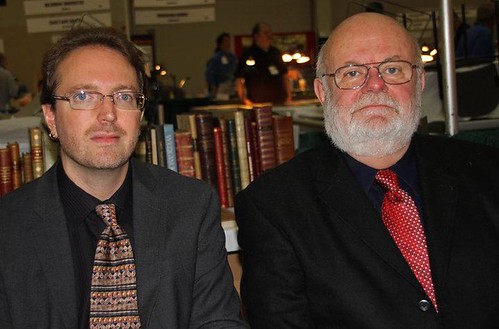
NEW BOOK: ANNUAL ASSAY COMMISSION – UNITED STATES MINT 1800-1943
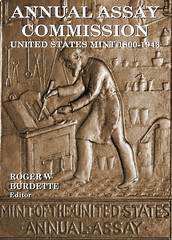 Seneca Mill Press LLC is proud to release a masterful 4-DVD set of U.S. Mint Assay Commission records from 1800 through 1943. Annual Assay Commission – United States Mint 1800-1943 edited by Roger W. Burdette includes nearly 2,000 high resolution images of original Commission meeting minutes in convenient PDF format.
Seneca Mill Press LLC is proud to release a masterful 4-DVD set of U.S. Mint Assay Commission records from 1800 through 1943. Annual Assay Commission – United States Mint 1800-1943 edited by Roger W. Burdette includes nearly 2,000 high resolution images of original Commission meeting minutes in convenient PDF format.
Astute collectors know the Assay Commission records are a gold mine of information about rare and mysterious coin issues. Yet, only a few privileged researchers have ever examined even small portions of these hand-written volumes.
This is the first and only published edition of these invaluable historic resources.
This 4-DVD set also includes original mint journals of:
- all silver and gold assay coins from 1818-1840,
- the Director's Annual Reports from 1796 to 1827,
- Mint auditor's reports to Congress from 1796 to 1820, and
- Selected Mint documents from 1786 to 1795.
Assay Commission minutes from 1840-1943 are in separate files for convenient copying to any personal computer. Additionally, all files are organized by coin date, rather then the date of the Commission meeting.
Prepared by numismatic research specialist Roger W. Burdette, this definitive collection was compiled and edited over a period of more than three years. Original documents from the National Archives in College Park, MD and Philadelphia, PA, and the Library of Congress were photographed and adapted for publication. With few exceptions, images are of manuscript and typescript meeting minutes. Although not directly searchable, these image files are easy to use and print for personal use.
Annual Assay Commission – United States Mint 1800-1943 is available in a special first edition to readers of The E-Sylum for $25 postpaid until November 10, 2010. The regular retail price is $75.
To order send check or money order for $25 to: Seneca Mill Press LLC, PO Box 1423, Great Falls, VA 22066.
Bibliographic Entry:
Burdette, Roger W., ed. Annual Assay Commission – United States Mint 1800-1943. Seneca Mill Press, LLC, PO Box 1423, Great Falls, VA 22066. DVD (set) 4 discs in case.
ISBN 978-0-9768986-3-4
American History; Economics; Numismatics
About the Author/Editor
Like many collectors, Roger W. Burdette began the hobby of coin collecting by attempting to fill cent and nickel albums from pocket change. During the 1970s he specialized in coin photography and produced the images for popular advertisements and hobby books. After a pause of several years, Mr. Burdette became interested in numismatic research. During more than seven years of research he has uncovered a wide array of new information including many previously unknown events.
Mr. Burdette is the author of three critically acclaimed numismatic research books: Renaissance of American Coinage 1905-1908, Renaissance of American Coinage 0916-1915and Renaissance of American Coinage 1916-1921. Each book was awarded the prestigious NLG Book-of-the-Year Award. The trilogy covers the origin, design and initial production of our nation's most beautiful coinage. He is also the author of A Guide Book of Peace Dollars released by Whitman Publishing in November 2008.
He has written numerous articles for Coin World magazine Coin Values magazine, Coins magazine and The Numismatist. He is a contributor to the Guide Book of United States Coins, the 8th and 9th editions of J. Hewitt Judd's United States Pattern Coins, Experimental and Trial Pieces, and the USPatterns.com website. He has also contributed to Whitman Publishing LLC books on double eagles, nickels, type coins, silver dollars, quarters and others, and contributed to David Lange's Complete Guide to Buffalo Nickels.
Mr. Burdette lives near Washington, DC with his daughters and canine editorial advisor, Ivan. He is employed by a nationally known nonprofit research and development corporation.
THE BOOK BAZARRE
NOVEMBER 18, 2010 AUCTION HIGHLIGHTEvelyn's 1697 Discourse of Medals, Featuring a
17th Century Engraving of the St. Patrick's Coinage.
An exceptionally fine example of this numismatic landmark work, with a remarkable pedigree. From the library of Rogers Ruding, it was purchased by Edward Hawkins on November 27, 1838 at the auction sale of coin dealer Matthew Young. Beyond comprising the first major history of English medals written in English, it is also thought to be the earliest publication to depict a St. Patrick's copper.
141 W JOHNSTOWN ROAD, GAHANNA OH 43230-2700
(614) 414-0855 • df@numislit.com • GFK@numislit.com
BOOK REVIEW: ASTRONOMICAL SYMBOLS ON ANCIENT AND MEDIEVAL COINS
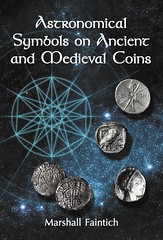 Astronomical Symbols on Ancient and Medieval Coins by Marshall Faintich (McFarland and Company, Inc. 2008. pp v+219. $55. ISBN 978-0-7864-3178-6.)
Astronomical Symbols on Ancient and Medieval Coins by Marshall Faintich (McFarland and Company, Inc. 2008. pp v+219. $55. ISBN 978-0-7864-3178-6.)
We met in a class in “Ethics in Physics” in the winter 2010 semester. Brad is an undergraduate physics major. Mike is a numismatist. The initial reviews of this book here on E-Sylum (v13n20.html#article4, v13n26.html#article6, and v13n29.html#article5) were compelling. We both enjoyed our first reads, but closer examination revealed much to be validated. Our final analysis is that this book offers at best a catalog of facts and assertions that can launch further study. For instance, any collector who wants to assemble an array of coins with comets (or those commemorating solar eclipses) should start with this book.
Nonetheless, the author's thesis is far from proved. According to Dr. Faintich, coins carry celestial symbolisms to validate the ruler's claim to a divine mandate. The author sets good standards for determining which coins support that theory:
“First, the date of a coin bearing an astronomical symbol must be ascertained. Second, the astronomical symbol must be the first such occurrence for that coin design or a re-introduction of the symbol after a substantial period of time to rule out immobilization of the design. Third, the occurrence of the astronomical event must be established. Fourth, and most difficult to ascertain, historical evidence must be presented that supports the observance and importance of the event. Without the latter, any correlation between a design symbol and an astronomical event is merely speculation.”
The story of Philip Augustus of France and the Five-Pellet Denier (pp. 22-24) does support the thesis by following those four steps. It is one of the few that do. Overall, the book is replete with confusing, inconsistent and self-contradictory explanations that switch between symbols representing the five visible planets, sun, moon, comets, solar and lunar eclipses.
When the author bounces around chronologically it makes the argument difficult to follow. Jumping back and forth from three-pellet to four-pellet to five-pellet configurations and jumping from 7th century to 4th century, 3rd century, 1st century A.D. to 15th and 17th century B.C.(pp 27-30) is undisciplined, no matter how interesting the facts may be in isolation. Most citations do not adhere to the author's own standards. He simply shows coins near a time and place when a celestial event was shown to have occurred based on modern astronomical software.
Dr. Faintich says that he used four programs. Unfortunately, he does not identify them. We also used four programs – Celestia, Starry Night Pro, Stellarium, and Night Vision – and we relied on a NASA database of eclipses (http://eclipse.gsfc.nasa.gov). We checked 60 of Faintich's claims and found 21 disagreements with our resources.
Dr. Faintich writes about regal coins as if they all came from the same central mint. He does acknowledge the Christmas 1124 mutilation of the moneyers at Winchester, but he never separates the outputs of the mints. Moreover, on the Continent, a plethora of independent mints operated for centuries. Controls were important. And these marks, even if they commemorate celestial events, could also serve the needs of the mint.
Dr. Faintich refers repeatedly to “the divine right of kings,” seemingly unaware that it is a Protestant idea, unknown in the Catholic Middle Ages. If the purpose of celestial symbols on coins is to show divine favor, it would be helpful to examine closely the coins of the Papacy, the Archbishopric of Canterbury and other ecclesiastic authorities. Similarly, the coins of dukes, counts, and independent cities could be examined, though they, too, are passed up.
The author denigrates the Church as an institution of anti-scientific superstition, never acknowledging the importance of astronomical computations to setting the days of feasts, especially Easter, which falls on the first Sunday after the first full moon following the vernal equinox. The hours of prayer were also set by astronomical observation.
Chapter 5, “Complex and Unusual Designs,” which offers conjunctions and constellations depicted on coinage is very convincing and well-paced. The complex celestial events are nicely depicted and clearly explained. The data supports the thesis. Chapter 10, “Beginnings,” delivers a very sound conclusion to a somewhat shaky text, putting the nine previous chapters into perspective. Appendix A, “Accuracy of Analyses,” addresses the technical problems in running the clock back over the centuries to redraw the sky.
Finally, as the authors here met in a class in “Ethics in Physics,” we must go on record to question whether Dr. Kavan U. Ratnatunga actually read this book closely and checked its data before publishing here in The E-Sylum.
Kavan Ratnatunga writes:
I checked only the Eclipse records since I know that Fred Espenak's GSFC catalog to be very reliable. I am unable to comment on the specific programs Wade and Marotta have used, but know that some which were developed for predicting recent events fail when projected back to the distant past. If, for example, the disagreements are concentrated with the oldest records then that shows only a difference between the precision of the programs that were used by Faintich and these reviewers.
I do not disagree with their comment about the three pellets - I did comment on it as well in a more diplomatic way.
The use of astronomical symbols on ancient and medieval coinage as representing actual celestial events has been debated for well over a century. More than 100 years ago, it was a popular topic and well supported by some of the leading numismatists of the time, including P.W.P. Carlyon-Britton, who at that time was the president of the British Numismatic Society. Unfortunately, numismatists of that period did not have the benefit of modern computers and modern data to support many of their hypotheses.
There was at that time, and it still persists today, some who do not agree with the hypotheses that I present in my book. However, there are also many who do agree with what I have written. Several problems exist that are difficult to defend with precision. First of all, many of the ancient and medieval coins are difficult to date. Second, parameters such as Delta-T that are used to compute geographic eclipse paths are not well-known prior to about 1600. All modern computers use different approximations for these parameters, and one can only assert approximate results. Finally, no one can be absolutely sure what was in the mind of the engraver when a die was made more than 500 years ago.
However, I have spent most of my career investigating patterns in data, and that is precisely what I have described in my book - a collection of examples of symbols on coins that can be associated with actual celestial events that is far from random chance. Those who have studied ancient and medieval history know very well that the heavens played an important role in decisions made by ancient sovereigns, and that there was on-going conflict between pagan beliefs and the teachings of the church.
Wade and Marotta wrote:
"If the purpose of celestial symbols on coins is to show divine favor, it would be helpful to examine closely the coins of the Papacy, the Archbishopric of Canterbury and other ecclesiastic authorities. Similarly, the coins of dukes, counts, and independent cities could be examined, though they, too, are passed up.
The author denigrates the Church as an institution of anti-scientific superstition, never acknowledging the importance of astronomical computations to setting the days of feasts, especially Easter, which falls on the first Sunday after the first full moon following the vernal equinox. The hours of prayer were also set by astronomical observation."
The coins of the Papacy would not use pagan symbols on their coins, and coins of many dukes, counts, and independent cities are described in my book. It appears to me that the reviewers are confusing astronomical computations used by the church with astrological beliefs that were practiced outside of the church. There was no intent on my part to denigrate any religion, and I do not understand why the reviewers believe this to be true.
Finally, the reviewers are stated to be a numismatist and an undergraduate physics major. I do not know these reviewers, and cannot comment on their qualifications other than what has been stated. However, parts of my book were peer reviewed by Bruce Brace, president of the Classical and Medieval Numismatic Society and the honorary curator of the numismatic collection at the McMaster Museum of Art, and by Owen Gingerich, senior astronomer emeritus at the Smithsonian Astrophysical Observatory and research professor of astronomy and of the history of science at Harvard University. Victor Failmezger, author of Roman Bronze Coins, provided detailed comments and expert opinions on the historical and numismatic aspects of Roman coinage, and Steve Ford, one of the world's experts on Anglo-Gallic coinage, co-authored a portion of chapter 9 and provided detailed comments on the rest of that chapter.
There will always be some who will disagree with what I written in my book, and others who will agree. Most of the readers who have either responded to me personally or posted comments elsewhere have given favorable reviews. Everyone is entitled to their own opinion. I don't know what else I can say about the review by Wade and Marotta, other than each reader should judge my book on its merits and come to their own conclusions.
To read the earlier E-Sylum articles, see:
NEW BOOK: ASTRONOMICAL SYMBOLS ON ANCIENT AND MEDIEVAL COINS
(www.coinbooks.org/esylum_v13n20a04.html)
BOOK REVIEW: ASTRONOMICAL SYMBOLS ON ANCIENT AND MEDIEVAL COINS
(www.coinbooks.org/club_nbs_esylum_v13n26.html#article6)
BOOK REVIEW: ASTRONOMICAL SYMBOLS ON ANCIENT AND MEDIEVAL COINS
(www.coinbooks.org/esylum_v13n29a05.html)
THE BOOK BAZARRE
BOOK REVIEW: NEW ZEALAND HISTORY NOTED
 ANY collector who scores a copy of
Robert Pepping's new, privately published,
243 pp. book in their Christmas
stocking has many happy hours of summer
reading to look forward to. This volume
is set to become the indispensable
reference on New Zealand post-1933
paper issues although its appeal should
be far broader than that. You don't have
to collect Kiwi currency to appreciate its
contents. The breadth of information it
provides is an invaluable reference for
all banknote students and collectors.
ANY collector who scores a copy of
Robert Pepping's new, privately published,
243 pp. book in their Christmas
stocking has many happy hours of summer
reading to look forward to. This volume
is set to become the indispensable
reference on New Zealand post-1933
paper issues although its appeal should
be far broader than that. You don't have
to collect Kiwi currency to appreciate its
contents. The breadth of information it
provides is an invaluable reference for
all banknote students and collectors.
The book is an in-depth account of the notes issued by New Zealand's central bank (RBNZ) from the 1930s to the present day. Robert presents his content in a digestible and entertaining manner. It can be read from cover to cover but is also well-suited for gently dipping into.
The fourteen chapters include: first and second issue RBNZ notes, decimal currency, note printing in NZ, the end of rag paper and the arrival of plastic, processing circulation notes, counterfeits, commemoratives, emergency issues, replacements, and note signatories.
Throughout, Robert provides packages of facts and figures boxed-out from the main text. These are a useful adjunct in that they amplify, supplement or illustrate a chapter's content. Nonetheless they can be skipped in a first reading of the book. Examples include the life expectancies anticipated by the RBNZ for their first note issue, details of second issue specimens, and the reaction by Alf's Imperial Army to Governor Brash's proposal to excise Her Majesty from New Zealand notes.
Readers who wish to point out to their resident Christmas Elf where they can purchase a copy, could point them to Robert Pepping at the book's website: http://nzhnoted.weebly.com; or e-mail: nzhnoted@gmail.com; or snail-mail: c/- Sacred Heart College, 250West Tamaki Rd, Glendowie, 1071, Auckland, New Zealand.
Just ask for New Zealand History Noted. Cost is A$70.00 plus A$8.00 p&p assuming current exchange rates hold. It is excellent value for money and I say this despite not owning one New Zealand note.
The changeover to decimal currency is deservedly given detailed coverage, as is the later Aussie connection with the change to polymer. One area that could have been usefully expanded is that of replacement notes, with a fuller explanation provided as to how these are utilised at different stages of the printing process.
The section on counterfeits and forgers may well prove new info for some readers. It is an area that the RBNZ says little about. They don't wish to encourage competition.
The book is profusely illustrated with images Robert has tapped from numerous sources. Top of the list is the Reserve Bank of New Zealand who gave him a fairly free run of their archives. Not far behind are Noble Numismatics, a host of newspapers, security printers, libraries, public archives and individuals, including the late Sir Ed Hilary. The result is the most comprehensive set of images yet assembled related to New Zealand's predecimal and decimal note history.
To read the earlier E-Sylum article, see: NEW BOOK: NEW ZEALAND HISTORY NOTED (www.coinbooks.org/esylum_v13n44a06.html)
BOOK REVIEW: DOCUMENT PREPARATION FOR CLASSICAL LANGUAGES
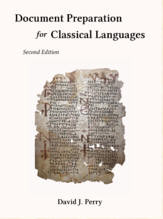 A number of us are interested in presenting classical languages -- in my case, numismatic inscriptions -- on the web or in other electronic documents. I recently purchased Document Preparation for Classical Languages by David Perry and find it to be excellent coverage of the topic.
A number of us are interested in presenting classical languages -- in my case, numismatic inscriptions -- on the web or in other electronic documents. I recently purchased Document Preparation for Classical Languages by David Perry and find it to be excellent coverage of the topic.
For those who deal with ancient language fonts on computers, I highly recommend this reference. It is available in a beautifully printed soft cover or PDF electronic edition. Check it out at
http://scholarsfonts.net/docproc.html
COLONIAL WILLIAMSBURG ACQUIRES NORTH CAROLINA COLONIAL CURRENCY HOARD
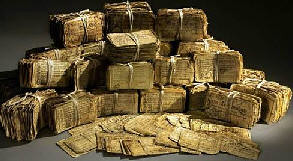 Colonial Williamsburg has acquired a large amount of cash, but it's not the kind the foundation can spend.
Colonial Williamsburg has acquired a large amount of cash, but it's not the kind the foundation can spend.
The collection of colonial paper currency was issued by North Carolina prior to the American Revolution.
Comprised of more than 6,600 notes in varying denominations issued between 1748 and 1771, the stash of cash was worth about 7,176 pounds sterling in 1775. If legal tender today, the currency would have purchasing power of more than $750,000.
Portions of the currency will be featured in a new coins and currency exhibit, “Dollars, Farthings & Fables: Money & Medals From the Colonial Williamsburg Collection,” opening in the DeWitt Wallace Decorative Arts Museum on Nov. 24.
“As the only known hoard of pre-Revolutionary War colonial paper money, the Cornell Hoard is truly exciting,” said Erik Goldstein, Colonial Williamsburg's curator of mechanical arts and numismatics. “Not only is the sight of such a huge pile of cash stunning, but it has much to offer students of early American coins and currency.”
Named the “Cornell Hoard,” the money was collected originally by Samuel Cornell, a transplanted New Yorker who became a wealthy merchant after moving as a young man to New Bern, N.C. in the mid-1750s. In addition to his activities as a merchant, Cornell also was involved in high risk currency speculation as evidenced by the hoard of colonial currency.
In 1769 as one of the wealthiest and most influential men in the North Carolina colony, Cornell underwrote the construction of a new governor's house in New Bern — the Tryon Palace — with a loan to the government of £8,000 in “proclamation money,” or colonial paper currency, which helped earn him an appointment to His Majesty's Council for North Carolina.
As an ardent Loyalist, Cornell seized another opportunity in 1771 to lend a lot of cash to North Carolina. He provided £6,000 to finance a military expedition to the western part of the colony to put down a small taxation rebellion. The skirmish became known as the Battle of Alamance, considering by some to be the opening salvo of the American Revolution. In addition to his loan, Cornell also sold £483 in supplies for the expedition to the colony.
On the eve of the Revolution, Cornell left New Bern and sailed for London in 1775. After two years there, he headed to British-occupied New York City. Before his death in 1781 at the age of 50, he was apparently able to transport his monetary cache to New York. His will, which specifically mentioned the “proclamation money of North Carolina,” left most of his wealth to his five daughters.
The bundles of currency apparently remained in the family until 1913 when it was offered, along with other Cornell papers to the New York Public Library, which published the letters as “Papers Relating to Samuel Cornell, North Carolina Loyalist.” The library, in turn sold the currency in its entirety to a dealer during the 1970s, who put half the collection up for sale. The other half, representing about 40% of Cornell's original stash and the last remaining intact portion, is now part of the Colonial Williamsburg numismatic collection, the gift of an anonymous donor.
To read the complete article, see: Colonial Williamsburg's latest buy: Money (www.vagazette.com/articles/2010/10/29/news/doc4ccad065d172a175716440.txt)
COIN REPLICAS AND THE HOBBY PROTECTION ACT
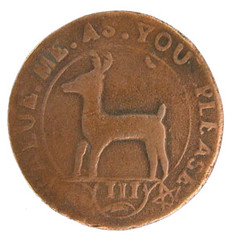

Regarding last week's image of a replica Higley copper, Leon Saryan writes:
I read the note (in your latest newsletter) about Rosa forgeries with some interest, since I just finished writing a paper on two of Rosa's ancient forgeries pertaining to Armenia. I am going to take a guess here (since I don't have the actual "coin" in front of me), but it seems that the word COPY stamped into the above "coin" does not seem to be large enough in dimensions or depth to meet the requirements of the Hobby Protection Act. These requirements are that the lettering be a minimum of 6 mm wide, 2 mm high, and 0.3 mm deep. I found the same problem in two Armenian coins that were purported to be Rosa copies.
Joe Boling writes:
The products of ReplicaCoins Corp are just going to cause problems down the road. For starters, their COPY marking appears to be only about 2/3 the size that the Hobby Protection Act regulations specify. We have already seen Gallery Mint products distressed so as to appear original (in conjunction with removal of the COPY stamp). ReplicaCoins pieces, being copies of lower grade originals to start with, will be even easier to disguise as genuine examples.
To read the earlier E-Sylum article, see: PETER ROSA APPRENTICE CHARLES DOYLE ANNOUNCES COIN REPLICA FIRM (www.coinbooks.org/esylum_v13n44a17.html)
THE BOOK BAZARRE
“New Book—Free Shipping”ON THE STICKNEY THREE CENT FEUCHTWANGER SPECIMEN

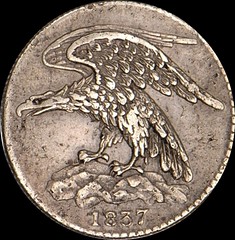
Joe Boling writes:
I disagree that the images of the obverse of the Feuchtwanger three-cent pieces are of the same coin. Granted, some of the appearance of the piece on the left could be artifacts of the digitization process, but I see many features of the images that do not match, and very few that seem to be matches. I await the comparison with a plated catalog.
Dan Hamelberg has a plated Stickney catalog. He writes:
In checking the Stickney Sale for the cent image, the image in the plated catalog is not entirely clear, but I think in comparison to the image in The E-Sylum, the marks and porosity in the fields of the coin sort of match up. The catalog image is really not much better than the one in The E-Sylum. This is why it is somewhat difficult to tell beyond a doubt that it is the same coin. I am not sure if it is absolutely conclusive, but I think it is close.
To read the earlier E-Sylum article, see: QUERY: WAS BOWERS' THREE CENT FEUCHTWANGER THE STICKNEY SPECIMEN? (www.coinbooks.org/esylum_v13n44a16.html)
NOTES FROM E-SYLUM READERS: NOVEMBER 7, 2010
Confessions of a Used-Book Salesman
Regarding a Slate article we highlighted a couple issues ago, Dick Johnson writes:
How do some used book dealers go modern these days? With a bar code scanner and software. These scavengers search thrift shops and library book sales for books with high potential resale. I enjoyed the tell-all article by one of these bar-code-scanner-toting book buyers this week. He reveals how he does it, though somewhat apologetically. It's an easy read. So much so I read it twice for the sheer pleasure. As a book lover you'll enjoy it as well, I'm sure.
To read the earlier E-Sylum article see: CONFESSIONS OF A USED-BOOK SALESMAN (www.coinbooks.org/esylum_v13n41a26.html)
Turkish Numismatic Contact Sought
Oded Paz writes:
I'm trying to contact ANY Turkish Numismatist or the Turkish Numismatic Society, without any luck. I found the name of Turkish Numismatist M. ISKENDER TARGAC on the E-Sylum archive, but without any contact info. Does anyone have any contact information for any Turkish Numismatist? Thanks so much.
Query: Louis Eliasberg
Joshua Holman posed this question to Dave Bowers, who forwarded it here:
I subscribe to Coin World and have read your "Joys of Collecting" column. I have a quick question. I recently was at doctor's appointment and was reading a Guinness World Records booklet that stated the Eliasberg collection was the most expensive coin collection. From what I've read online, Eliasberg had a complete set of gold, silver, and copper coins. Did the collection include modern day coins such as the Lincoln cent?
Dave responded:
It was complete in all series. You can borrow the catalogs from the American Numismatic Association Library, also the book I wrote, Louis Eliasberg: King of Coins, now out of print. If you want to BUY these you can find some book dealers listed in The E-Sylum, an e-mail newsletter you would probably like to know about anyway. Best of success with your collecting interest. Thank you for writing.
LOUIS ELIASBERG'S 1873-CC NO ARROWS DIME LETTER OF RECEIPT
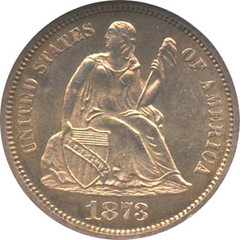
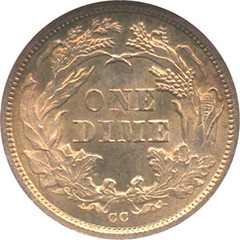
Along the lines of Carson City ephemera, I would be remiss in not mentioning the recent Stack's Americana sale, lot #4132, which auctioned on October 1st, 2010. This lot contained Louis Eliasberg's letter to Sol Kaplan, dated November 7, 1950, in which Eliasberg acknowledged receipt of the 1873-CC No Arrows dime, which he had purchased from Kaplan for $4,000.
Eliasberg considered this the last coin in his now complete collection of US coins (the 1870-S half dime was not known at the time, and it was discovered much later that one of his three-cent nickels was actually a pattern). This letter auctioned for a staggering $8,050, or more than twice what the 1873-CC NA dime sold for in 1950!
I am not sure who won this lot, although I can say that the under bidder owns a marvelous collection of Liberty Seated Carson City coinage, and I suspect the same is true of the successful bidder.
From the auction lot description (it actually contained five letters):
A landmark piece of correspondence from the Eliasberg archives. Also included is Mr. Eliasberg's copy of the letter he sent to Joseph Stack along with payment for the 1853-O No Arrows half dollar from the Menjou Sale, noting that this was the next to last coin needed to complete the collection. Finally, two more letters dated August 1 and 2, 1950 mention a letter from “Mr. Williams,” likely a letter relating to the 1873-CC dime, as Charles M. Williams of Cincinnati was the previous owner of the coin. A highly important lot documenting the completion the Eliasberg Collection.
To read the complete lot description, see: Louis Eliasberg's copy of his November 7, 1950 letter to Sol Kaplan (stacks.com/Lot/ItemDetail/181246)
Only one example of the 1873-CC "NO Arrows" Dime is known to exist.
Ex: U.S. Mint Collection until 1909 when traded along with several crates of patterns and other coins for two 1877 gold Half Unions in the collection of Treasury Secretary, William Woodin.
1914 ANS Exhibit - "Collection of a Prominent American" (Wayte Raymond, May 1915) - Rudolph (Rud) Kohler Collection - Charles M. Williams Collection - sold as part of the Adolphe Menjou Collection (Numismatic Gallery, June 15, 1950), where it sold for $3,650 - James Kelly and Sol Kaplan - Louis E. Eliasberg, Sr. on November 7, 1950 as the last piece needed for his complete set of U.S. coins
The exact circumstances surrounding the production of this issue are unknown, but Mint records indicate that 12,400 pieces were struck. Presumably all were melted and converted to Arrows Dimes with the exception of a few saved for assay purposes. The theory is that this single coin was saved from the destructive testing done by the Assay Commission. Probably one of the assay members was able to trade it for face value at the time by merely exchanging another Dime for it. It was apparently kept in the Mint collection for several decades where it was well preserved, not appearing again for 36 years.
"In 1909, Philadelphia dealers John Haseltine and Stephen Nagy sold a pair of 1877 gold Half Union patterns for the unprecedented price of $10,000 each. The buyer was future Secretary of the Treasury, William Woodin. A short paragraph from the Bower's Eliasberg catalog describes what happened next: "A furor arose, and it was said that the pair of $50 gold patterns never should have left the Mint. The two pieces were returned to the Mint by exchange, in which "several crates" of coins--thousands totally, primarily patterns, but possibly including some other issues as well--were given to Haseltine and Nagy by Mint officials. What a treasure trove this was!"
The read the complete CoinFacts description, see:
1873-CC DIME -
No Arrowheads at Date
(www.coinfacts.com/dimes/seated_liberty_dimes/
1873cc_no%20arrows_dime.htm)
AUTHOR FRED REED SEEKS ASSISTANCE FOR LINCOLN BOOK SEQUEL
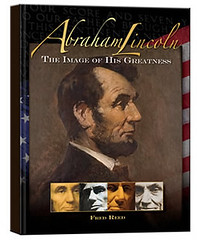 I've accepted my publisher's challenge to write a sequel to my very successful book for the Lincoln Bicentennial, "Abraham Lincoln, The Image of His Greatness" (Whitman, 2009). The working title is "Abraham Lincoln, Beyond the American Icon".
I've accepted my publisher's challenge to write a sequel to my very successful book for the Lincoln Bicentennial, "Abraham Lincoln, The Image of His Greatness" (Whitman, 2009). The working title is "Abraham Lincoln, Beyond the American Icon".
Knowing full well that most sequels flop, I am taking my inspiration from Augustus Saint-Gaudens. Even after sculpting the widely-acclaimed greatest Lincoln statue, his Standing Lincoln for Chicago's Lincoln Park in the mid-to-late-1880s, he accepted a commission from the same source to do another Lincoln memorial for the Windy City. Saint-Gaudens labored 12 years on a second masterpiece. He completed the statue in 1906, but died before it was cast. Eventually after exhibitions of his bronze Seated Lincoln on both coasts to great acclaim, it was installed in Chicago's Grant Park in 1926, a fitting memorial to both its subject and sculptor.
The new book will be similar in its presentation to the first book, but will expand upon my themes and allow me to drill down on some points that I want to reiterate. The new AbeBook will have entirely new text and 100% new art. It will be a complete book in itself, but also a natural companion to the first AbeBook.
I don't have a dozen years to work the kinks out of my sequel. The book is slanted toward interest in the Civil War sesquicentennial. It is due out next summer. The manuscript is due November 29th! I am looking for exceptional, interesting, or even quirky Lincolniana to illustrate in the new book. If you have items of interest that you'd like to share with the hobby, please email high resolution scans to me through my website www.fredwritesright.com. All contributors will be acknowledged, unless they request anonymity.
QUERY: GERMANY REPARATIONS COMMISSION PHOTO
An E-Sylum reader writes:
"The Library of Congress contains an image entitled: "Reparations Commission with Stevenson, 6/25/29".
If this is indeed the Inter-allied Reparations Commission then it decided on the size and conditions of Germany's WWI wergild. As such they all exercised a profound effect on numismatics in the 20th century. One had already attached his signature to a large number of banknotes. Collectively their decisions would contribute in no small manner to German's hyperinflation.
The LoC record does not identify them. Can the historians among e-Sylum readers identify any or all of them? One at least may have been a U.S. Vice-President.
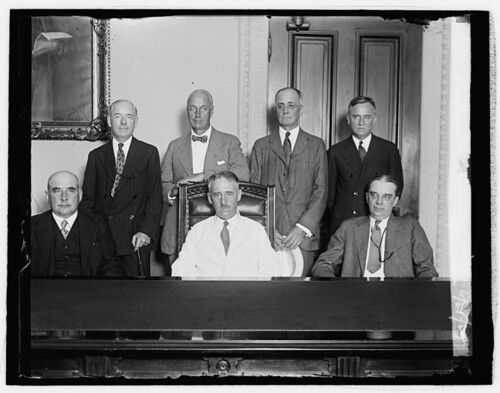
QUERY: TAYLOR & CHALLEN MEDAL INFORMATION SOUGHT
Web site visitor Graeme of Glasgow, Scotland writes:
I am currently in possession of a small coin which I believe may have some history, however I am looking for some information. The coin has printed on one side 'Taylor and Challen Ltd Birmingham' and on the other side 'Minting Machinery'.
The coin belongs to me after it was given to me by a member of my family a long time ago. If you have any information, I would greatly appreciate any response. Thanks in advance
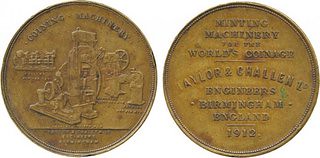
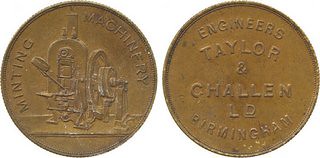
To read the earlier E-Sylum articles, see:
TAYLOR & CHALLEN COIN PRESS INFO SOUGHT
(www.coinbooks.org/esylum_v07n39a09.html)
THE HISTORY OF COIN PRESSES
(www.coinbooks.org/esylum_v07n40a03.html)
THE BOOK BAZARRE
NEW FRONTIER CONGRESSIONAL GOLD MEDAL DESIGNS
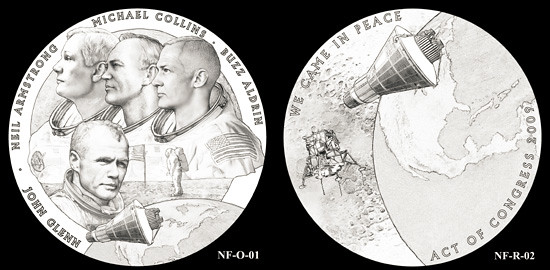
I attended the October 26th meeting of the Citizen's Coinage Advisory Committee in the Mint's headquarters in Washington, D.C., and witnessed the members' discussions of the obverse and reverse designs for the New Frontier Congressional Gold Medal. The medal honors the space missions of John Glenn aboard Mercury Atlas 6 (first American to orbit the Earth) and of Neil Armstrong, Buzz Aldrin, and Michael Collins aboard Apollo 11 (first and second people to set foot on the Moon, and the pilot of the mission command module).
There were a total of four different obverse design candidates and seven different reverse design candidates provided by the United States Mint.
I disagree with Donald Scarinci's suggestion that the text “Act of Congress 2009” be removed from reverse. Les notes that the text is a tradition of Congressional medals, but not a requirement. A motion to remove it passed on a 5-to-4 vote.
Here's why I like it. It's very hard to get the Congress of the United States to agree on much of anything, and it's a true honor when the elected representatives of the people bestow a medal. It's not like the President doling out medals to every Tom, Dick and Harry like he's tossing handfuls of Mardi Gras Doubloons. It literally takes an Act of Congress, and that's a Big Deal. If I'd been on the Commission, my vote would have been to keep the phrase.
The more interesting part of the article is probably not what Les has written, but the comments posted by readers. As of this writing the opinions were universally against the inclusion of John Glenn over Alan Shepard. Most believed the choice to be politically motivated. -Editor
"Joe" writes:
Why is John Glenn on the coin? I realize he was the first American to orbit, but why not Alan Shepard who was the first American into space? Could it be that John Glenn was a famous democrat senator?
Richard Stinchcomb writes:
I also find the inclusion of John Glenn very controversial. It is an either/or situation. Either use what applies for one specific purpose, or make different medals for each purpose. In terms of a specific meaning, absolutely none of these coin designs convey a universal concise meaning. This is why everyone is questioning why John Glenn is on these coin designs. Either, you have John Glenn as the first American to orbit the Earth, or you have Neil Armstrong as the first person to touch the surface of the moon. Neil Armstrong is a pioneer, however the same cannot be said for John Glenn since he was not the first person to orbit the Earth. The first person to orbit the Earth was a Russian. This is why the designs have no direct correlation in meanings and therefore make no sense.
To read the complete article, see:
New Frontier Congressional Gold Medal Designs Reviewed by CCAC
(news.coinupdate.com/new-frontier-congressional
-gold-medal-designs-reviewed-by-ccac-0518/)
W.S. HILL BASEBALL ADVERTISING NOTE
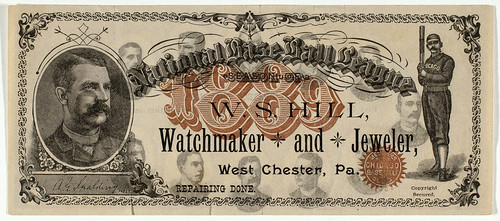
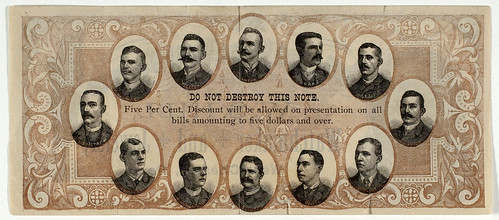
Advertisers have long used the image of popular baseball players and baseball teams to hock their wares. If you think it's a 20th (or 21st) century phenomenon, think again. In the American Antiquarian Society's collections there are many examples from the 19th century of advertisers associating themselves with baseball.
One nice example is a bank note advertisement from 1889. W.S. Hill, Watchmaker and Jeweler from West Chester, Pennsylvania issued a flyer, made to resemble currency, with an image of Albert Goodwill Spalding and a generic Chicago White Stocking player on the front and portraits of twelve members of the 1888 Chicago White Stockings on the reverse. The White Stockings, who would become the Cubs in 1903, did not win the National League pennant in 1888 (the first World Series was still 15 years away) and came in third in 1889 so we're left to wonder why a Philadelphia area jeweler chose a team from Chicago in its advertising.
To read the complete article, see: Prices BATTED to Pieces (pastispresent.org/2010/good-sources/prices-batted-to-pieces/)
THE BOOK BAZARRE
NOVEMBER 18, 2010 AUCTION HIGHLIGHTA Nautical Almanac for the Year 1803
Signed by Early Naval Hero Thomas Truxtun
Published in 1796 by the Commissioners of Longitude, this work was traditionally issued years in advance. This almanac may well have accompanied the commander of the USS Constitution when Truxtun captured the French frigate L'Insurgente in 1799 and during the successful encounter in 1800 with La Vengeance. As a result of these actions, President Jefferson presented Truxtun with the first Congressional medal to have been made in the United States.
141 W JOHNSTOWN ROAD, GAHANNA OH 43230-2700
(614) 414-0855 • df@numislit.com • GFK@numislit.com
1980 LAKE PLACID OLYMPIC HOCKEY GOLD MEDAL SELLS
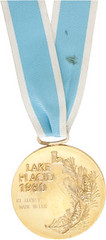 1980 U.S. Hockey "Miracle on Ice" Olympic Gold Medal Presented to Mark Wells. They finally made a movie about it in 2004. It had to be done, and it's frankly surprising that it took almost a quarter century for "Miracle" to hit the big screen, Kurt Russell providing star power as coach Herb Brooks. If it hadn't actually happened, Hollywood screenwriters should have dreamt it up, the archetypical David vs. Goliath story, a ragtag band of American amateurs facing the Soviet elite, set against the backdrop of the Cold War. But one wonders if the audiences could have possibly suspended disbelief during the glorious third act if it wasn't actually a true story.
1980 U.S. Hockey "Miracle on Ice" Olympic Gold Medal Presented to Mark Wells. They finally made a movie about it in 2004. It had to be done, and it's frankly surprising that it took almost a quarter century for "Miracle" to hit the big screen, Kurt Russell providing star power as coach Herb Brooks. If it hadn't actually happened, Hollywood screenwriters should have dreamt it up, the archetypical David vs. Goliath story, a ragtag band of American amateurs facing the Soviet elite, set against the backdrop of the Cold War. But one wonders if the audiences could have possibly suspended disbelief during the glorious third act if it wasn't actually a true story.
Everybody knows that the 1980 US Olympic Hockey round-robin match between the USSR and the US was expected to be a painfully lopsided affair. Of the twenty players who made the final roster of the US team, only one had prior Olympic experience. The rest were primarily college kids, nine of them members of Herb Brooks' University of Minnesota team. Four more were from Boston University. The Soviet players were classed as amateurs, but were effectively supported by the Soviet government which provided them with world-class training facilities and unlimited professional-level team play. Three of the Soviet team members, goalie Vladislav Tretiak and forwards Valeri Kharlamov and Viacheslav Fetisov, are today enshrined in the Hockey Hall of Fame. Not a single player on the American team can boast that distinction.
Three times the Soviets took the lead, and three times the Americans battled back to even footing. The game-winner would come with ten minutes left to play, when Mike Eruzione, left undefended in the high slot, scored the fourth goal for the home team, sending the Lake Placid crowd of 8,500 into hysterics. But nothing could match the decibel level as sportcaster Al Michaels gave his famous, game-closing call:
"Eleven seconds, you've got ten seconds, the countdown going on right now! Morrow, up to Silk. Five seconds left in the game. Do you believe in miracles?...YES!"
Though the United States team would need one more come from behind victory, against Finland, to clinch the top level of the Olympic podium, their victory over the seemingly invincible Russian juggernaut is widely recognized at the greatest moment in American sports history. Never before has the ultimate symbol of that victory been made available to the collecting public before now, as Heritage Auction Galleries proudly presents the 1980 Olympic Ice Hockey Gold Medal presented to twenty-one year old center Mark Wells for his contributions to the historic cause.
Crafted by the illustrious "Tiffany & Co.," the extraordinary prize offers world class aesthetics befitting its historic importance. The obverse provides a raised torch framed between the words "XIII Olympic Winter Games" and the Olympic rings. The reverse utilizes conifer imagery at right to balance the raised text "Lake Placid 1980" and the engraved lettering "Ice Hockey, Mark Wells." The medal measures three and one-eighth inches in diameter, and hangs from its original powder blue and white ribbon.
The medal exhibits light handling wear and the ribbon some minor staining, but certainly nothing which could begin to distract from its immeasurable appeal. It is accompanied by Wells' lengthy and eloquent letter of provenance, which closes with the words, "I hope you cherish this medal as much as I have. I personally cannot think of another piece of memorabilia that has had such a profound effect on the sports world than this precious keepsake."
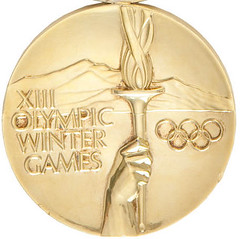
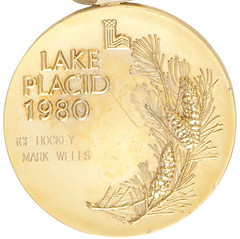
To read the complete article, see: (sports.ha.com/common/view_item.php?Sale_No=7028&Lot_No=81421)
QUERY: REPLACEMENT VICTORIA CROSS MEDALS
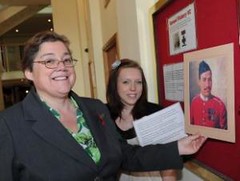 A MEDAL presentation will be made for one of Chard's biggest military heroes during the commemorations in the town on Saturday.
A MEDAL presentation will be made for one of Chard's biggest military heroes during the commemorations in the town on Saturday.
Replica medals will be unveiled for Victoria Cross recipient Cpl Vickery in a presentation ceremony by his distant relative Penny Herrick.
The medals will be on display at the Guildhall from next week.
Penny said: “I think it is a terrific honour to be asked to unveil the medals – he was such a fantastic person.”
Cpl Vickery was born in 1873 in Wambrook and when he was 24 he served in the Dorsetshire regiment taking part in the Tirah campaign on the northwest frontier of India.
He was presented with his Victoria Cross on October 20, 1897 as during an attack on Dargai Heights he rescued a wounded comrade under heavy fire.
Queen Victoria herself presented Cpl Vickery with the medal at the military hospital at Netley, Southampton.
On July 16, 1898, Cpl Vickery was invited to a civic reception in Chard and was presented with a gold medal by the mayor of Chard.
To read the complete article, see:
Corporal Vickery's replica medals to be unveiled in Chard on Saturday
(www.thisisthewestcountry.co.uk/news/8486951.Corporal_Vickery
_s_replica_medals_to_be_unveiled_in_Chard_on_Saturday/)
METAL DETECTORIST FINDS UNUSUAL COUNTERFEIT ROMAN COIN
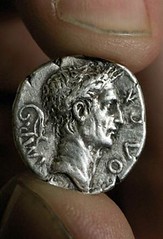 A Roman coin discovered by a Brighton cleaner was struck at the time of Christ by a "Del Boy" forger who could not spell and did not know one emperor from another, it was claimed today.
A Roman coin discovered by a Brighton cleaner was struck at the time of Christ by a "Del Boy" forger who could not spell and did not know one emperor from another, it was claimed today.
Experts say the coin is a mystery because it is made from solid silver and probably cost the forger as much to make as he received in profit.
The British Museum has never seen anything like it and its rarity has pushed up its value from £100 for a genuine coin to at least £3,000.
The silver denarius is based on coins struck to commemorate the Battle of Actium between Octavian and the combined forces of Mark Antony and Cleopatra in 31BC.
But experts have revealed that the forger got most of his inscriptions wrong.
He crafted his denarius some years after the battle but had a poor memory of what the real coin looked like, it has been claimed.
On one side is a crocodile but it is facing the wrong way and on the other side is the head of Emperor Caesar when it should have been Augustus.
The forger made a further mistake by mis-spelling Egypt. He inscribed Aegipto instead of the common spelling of the time, Aegypto or Aegvpto.
Sam Moorhead, national finds adviser for ancient coins at the British Museum, said the poor spelling "suggests the die cutter is not fully literate".
He said: "Interpreting the coin is difficult. Were it a (silver) plated piece, then it would have been explicable as an attempt to create a coin for profit by using a smaller amount of silver.
"However, why would someone create a fantasy piece like this in the ancient period from solid silver? As such, the coin is a mystery."
Mr Clements, who lives in Brighton, said: "I never thought I'd find anything so interesting and valuable and so soon after getting a detector.
"I would have been thrilled finding a genuine coin but this fake could mean a big difference to my life. I've always loved history but never bothered much at school.
"Now I'm seriously looking into the idea of selling the coin and putting it towards a degree here at the university.
"I hope to study more about the Romans. It's fascinating that there were forgers at the time, some, it seems, who were not very bright.
Stuart Williams of Ireland adds (on Flickr):
An X-ray fluorescence test should settle the question if it's a contemporary or a later copy. The test is non-destructive and one of the least expensive metallurgical investigative techniques for analysis of elements and isotopes.
I'd be suprised if the British Museum did not request a test on this interesting coin. There is a well equiped engineering department in the nearby University of London.
To read the complete article, see:
Brighton cleaner finds "Del Boy" Roman coin with first metal detector
(www.theargus.co.uk/news/8491675.Brighton_cleaner
_finds__Del_Boy__Roman_coin_with_first_metal_detector/)
INTERESTING CUTOUT ISABELLA QUARTER PIN
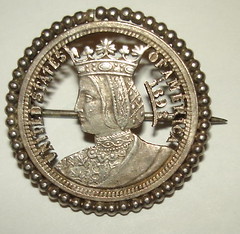

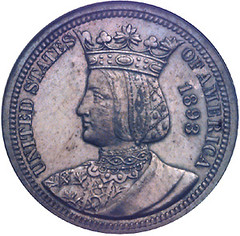
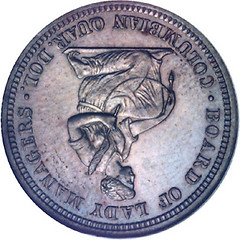
To view the complete eBay listing, see: 1893 Isabella Quarter Love Token Pin Cutout - VERY RARE (cgi.ebay.com/ws/eBayISAPI.dll?ViewItem&item=380285114006)
QUERY: ASHBURY PARK SIDEWALK DOLLARS
Chick Ambrass writes:
We're in California visiting our son Chas. We went up to Haight & Ashbury and walked thru Ashbury Park. Just outside the park in the cement in the sidewalk are a dozen or so $1 bills imbedded in the concrete. Do any readers of The E-Sylum know the story behind this?
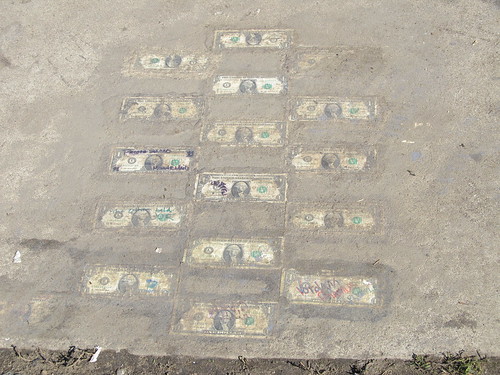
FEATURED WEB SITE: COUNTERFEITING
This week's Featured Web Site is suggested by John and Nancy Wilson, of Ocala, FL, who write:
We found a site that would be very useful for readers of The E-Sylum. It deals with counterfeits and has many helpful links regarding that subject. As you know counterfeits are very harmful to the numismatic hobby and it is always great when a site is devoted to the subject. Lots of information is on the site including some great references. You will also find links for money artists James Stephen George Boggs and Timothy Prusmack. Though some don't like Wikipedia it is always an interesting place to find out information on almost anything.

From the Wikipedia page:
Counterfeiting is as old as money itself. Coinage of money began in the Greek city of Lydia around 600 B.C. Before the introduction of paper money, the most prevalent method of counterfeiting involved mixing base metals with pure gold or silver. A common practice was to "shave" the edges of a coin. This was known as "clipping." While not itself counterfeiting, the exponents were able to use these precious metal shavings to create counterfeits. A fourrée is an ancient type of counterfeit coin, in which a base metal core has been plated with a precious metal to resemble its solid metal counterpart. Rulers often dealt very harshly with the perpetrators of such deeds.
Both in the United States, and England, counterfeiting was once punishable by death. Paper currency printed by Benjamin Franklin often bore the phrase "to counterfeit is death."[4] The theory behind such harsh punishments was that one who had the skills to counterfeit currency was considered a threat to the safety of the State, and had to be eliminated - another explanation is the fact that issuing money that people could trust was both an economic imperative, as well as a (where applicable) Royal prerogative - therefore counterfeiting was a crime against the state or ruler itself, rather than against the person who received the fake money. Far more fortunate was an earlier practitioner of the same art, active in the time of the Emperor Justinian. Rather than being executed, when Alexander the Barber was apprehended, the Emperor chose to employ his talents in the government's own service
en.wikipedia.org/wiki/Counterfeit_money
